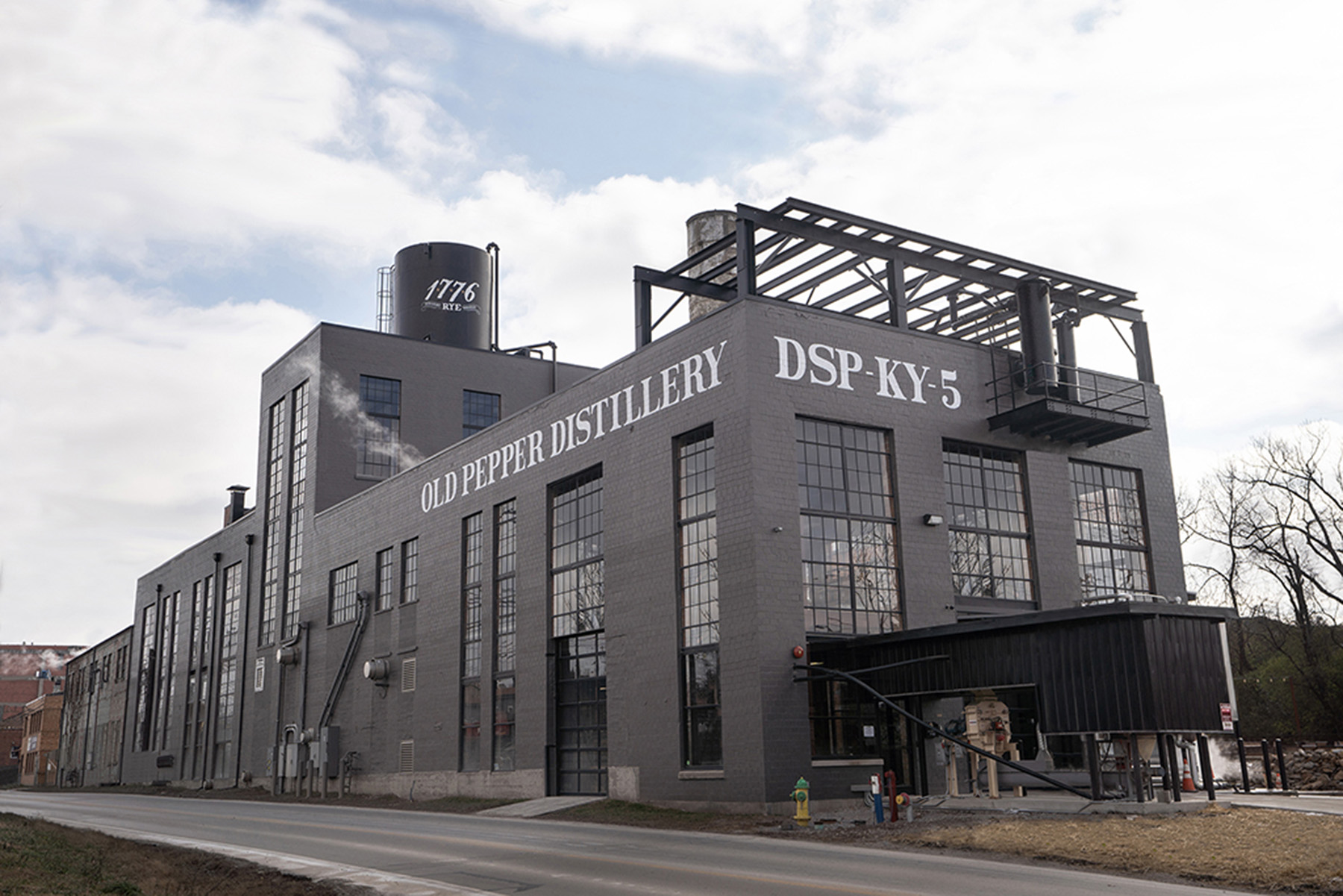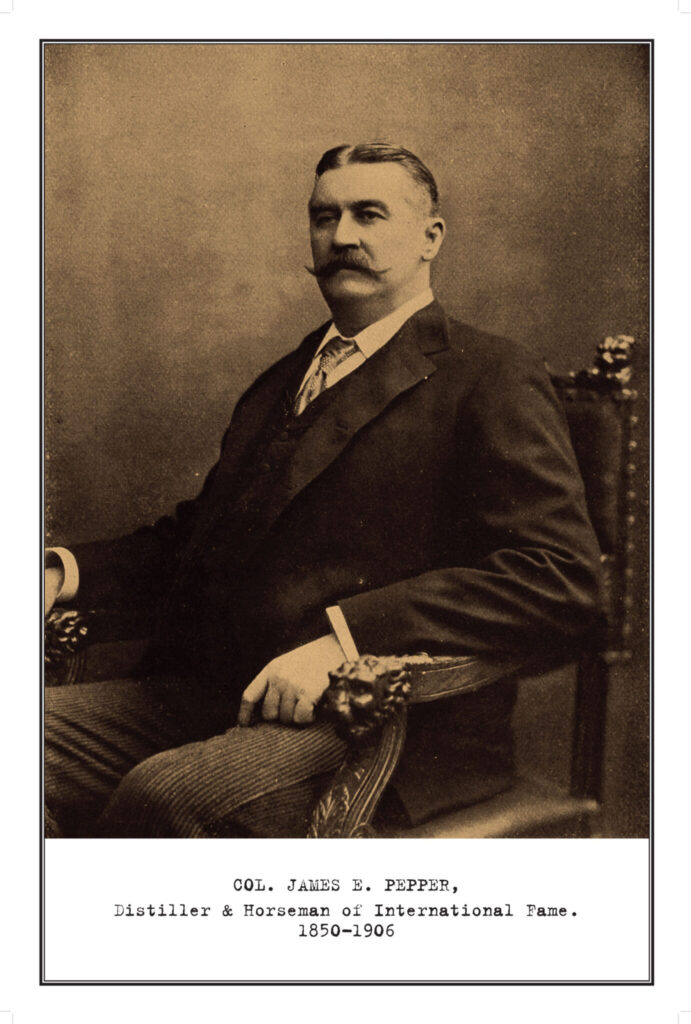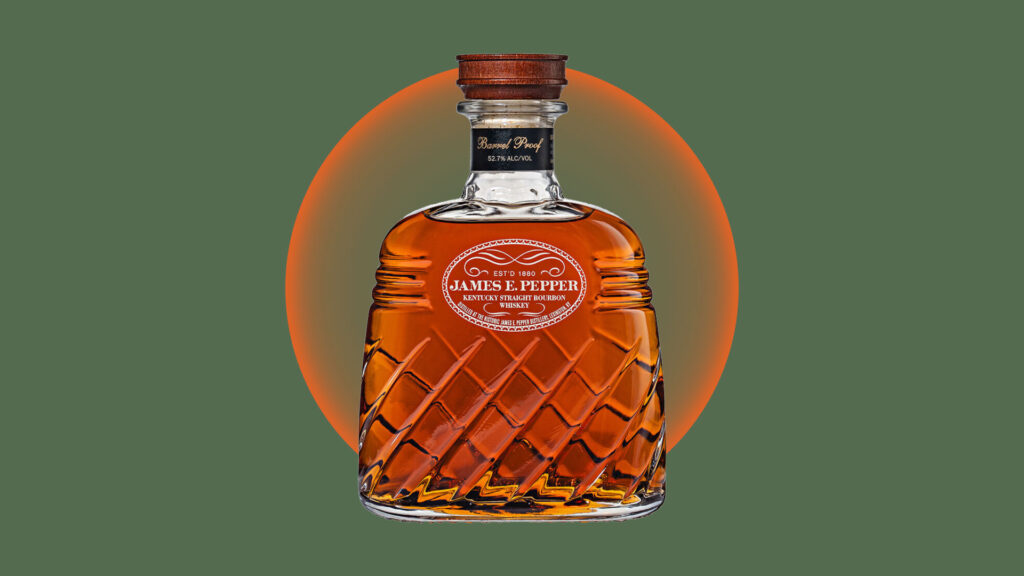Inside the Revival of the Historic James E. Pepper Distillery

(Photo: James E. Pepper)
In downtown Lexington, Kentucky, lies a historic distillery renowned for a certain stout glass bottle, its elegant lines and wide mouth harkening back to a bygone era. This is James E. Pepper’s Decanter Bourbon, a fusion of history, craftsmanship and modern sensibility that’s become popular among whiskey enthusiasts both for its distinctive statement-maker of a bottle and the well-reviewed liquid that rests within. Aged five to six years, blended from core mashbills distilled entirely in-house and bottled at barrel proof, it represents both the legacy of one of Kentucky’s oldest whiskey families and the vision of its modern steward, Amir Peay.
A Whiskey Lineage Rooted in Revolution
The Pepper family name is woven into the fabric of American bourbon history. According to family legend, Elijah Pepper began distilling whiskey during the American Revolution, moving west from Virginia to Kentucky. By 1812, he had established a distillery in Versailles, on the site that Woodford Reserve’s distillery operates on today. Elijah’s son, Oscar Pepper, expanded operations and brought in Scottish chemist Dr. James C. Crow, perfecting the sour mash process that endures across heritage distilleries today.
“It really created a whiskey of very high quality that people began to take note of and began to call out by name,” Peay told us. “So, they might call it out as Old Pepper or Old Crow. This was at a time when nobody bottled their whiskey; whiskey was sold by the barrel, and the distillery was the old Oscar Pepper Distillery.”

Col. James E. Pepper himself. (Photo: James E. Pepper)
James E. Pepper, Oscar’s son, inherited the family business at the age of 15. With the guidance of family friend and guardian Colonel E.H. Taylor, James would grow the distillery into one of the largest and most technologically advanced in the United States by 1880. But he was also a reformer. Frustrated by adulterated whiskey and restrictive laws, James helped champion the Bottled-in-Bond Act of 1897, ensuring consumer protection and setting a standard for quality that still matters today.
“James Pepper along with E.H. Taylor were two of the biggest proponents of the Bottled-in-Bond Act,” Amir explained. “Taylor gets a lot of credit as he rightfully should, but James was right there with him.”
Amir Peay’s Quest to Resurrect a Lost Brand

Amir Peay poses with an award from the Distilled Spirits Council of the United States. (Photo: James E. Pepper)
Fast forward to 2007: Amir Peay, a self-described history buff with a background in restaurants, bars and boxing journalism, discovered the Pepper brand while exploring archives related to Jack Johnson’s championship boxing matches. “In the middle of the ring was a banner that said James E. Pepper Whiskey, Born with the Republic,” he recalls.
Intrigued by a defunct brand with roots stretching back over two centuries, Peay began digging into its history. “I just can’t believe this brand is defunct and no one knows about it and nobody cares,” he said. From a small Lexington apartment, he acquired the brand rights and spent nearly two decades building archives, collecting historic bottles, mechanical drawings and memorabilia — all to resurrect an authentic James E. Pepper Whiskey.
Rebuilding the Historic Distillery
The physical revival was equally ambitious. The distillery, abandoned for 50 years, had fallen into disrepair, but Peay saw potential. Its masonry walls and beams forged by Bethlehem Steel — the same company whose steel was used to craft the Empire State Building and Golden Gate Bridge — provided a solid foundation for restoration.
After years of negotiations and meticulous planning, construction began in 2016. By late 2017, distillation resumed using original historic mashbills as well as various other mashbills designed to have optimal flavor profiles for blending with the other recipes. The 27-foot column still was custom designed by Vendome in Louisville — the same company that built the previous James E. Pepper still in 1934. The design was inspired by mechanical drawings Peay acquired in his research.

(Photo: James E. Pepper)
The distillery operates with a carefully sourced mix of ingredients: 100% locally grown corn, Kentucky oak barrels air-seasoned 18-24 months and water from a historic distillery well 200 feet underground. At this point, James E. Pepper is producing about 2,000 barrels of whiskey per year.
“2,000 barrels may be what the big guys make in a couple of days, but that’s a lot of whiskey,” Peay said. “And we have the ability to grow over time. This is the whiskey business; it takes time to work with distributors and to grow things, and we’re not in a rush.”
The Decanter Bottle: A Flagship for History and Modern Taste

At the center of James E. Pepper’s modern revival is the Decanter Bottle. Modeled after a 1945 design, Amir selected it for its timeless aesthetic.
“I just always was drawn to that bottle,” Peay explained. “It’s sturdy and it’s compact, but it’s also kind of classic and elegant and timeless.”
The Decanter Bourbon is not intended as a limited release but as an approachable everyday sipper. At a target price point of around $65, the bottle is characterized by accessibility without compromising quality. The bottle’s wide mouth and pleasing aesthetic has made it a popular choice for enthusiasts to use for their custom “infinity blends” once they finish the bourbon.
Blending Tradition and Innovation
James E. Pepper Whiskey honors its roots while innovating within tradition. Mashbills adhere to historical records, and the approach is similar to how James E. Pepper originally made his whiskeys, blending different mashbills crafted from various combinations of corn, rye, malted barley and malted rye.
The 1776 line, which initially relied on contract distillate, remains competitively priced at around $28, emphasizing transparency and value. Today, the 1776 rye is entirely distilled in-house, while the bourbon is the only expression in James E. Pepper’s portfolio that still uses third-party distillate.
“We want to honor the history but also to push the envelope a little bit, just like James Pepper did,” Peay said. “We want to expand and do new things while respecting the guidelines and the tradition.”
An Urban Bourbon Experience in Lexington
Located on the Kentucky Bourbon Trail, James E. Pepper Distillery offers one of the state’s highest-rated distillery tours, blending historical storytelling with production insight. Visitors can experience the history of the brand in the distillery’s museum, tour the historic steel and copper still system and experience a piece of bourbon history in the heart of Lexington.
A Stewardship of History and Flavor
For Peay, reviving James E. Pepper Whiskey has been a labor of love spanning nearly two decades. The Decanter Bottle, historic distillery and meticulous attention to mashbills, barrels and glass design are not just commercial choices but acts of stewardship for one of Kentucky’s foundational bourbon brands.
It’s kind of been a labor of love and and a passion of mine,” said Peay, who is the sole owner of the business and has taken on no investors nor sold to a conglomerate. “This is a long game. This is not a game you get into thinking short-term. And so, we’re still in the early innings, but we’re having a lot of fun, we consider ourselves very fortunate to to be doing well.”
Follow The Daily Pour:
About The Daily Pour
Founded by Dan Abrams, The Daily Pour is the ultimate drinking guide for the modern consumer, covering spirits, non-alcoholic and hemp beverages. With its unique combination of cross-category coverage and signature rating system that aggregates reviews from trusted critics across the internet, The Daily Pour sets the standard as the leading authority in helping consumers discover, compare and enjoy the best of today's evolving drinks landscape.
